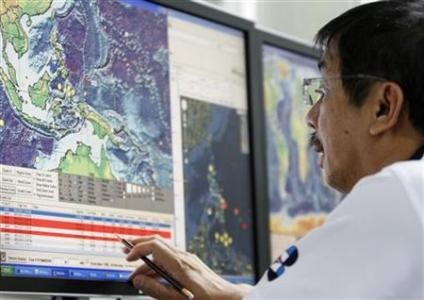
A strong earthquake measuring 7.6 on the Richter scale jolted the eartern coast of Philippines on Friday damaging roads and bridges in the country, and forcing people to flee fearing tsumani.
The tremor struck at 12:47:34 UTC (18:17:34 IST)on Friday according to United States Geological Survey (USGS). The quake struck 96km (60 miles) east of Sulangan, Philippines and was felt in places like Guiuan, Borongan, Surigao and Manila.
The Pacific Tsunami Warning Center issued alert for the Philippines, Japan, Indonesia, Taiwan, Papua New Guinea, the U.S. state of Hawaii and other islands in the Pacific but was called off a couple of hours later. However, Philippine authorities maintained their tsunami warning after ordering residents to get out of coastal areas immediately, reported Reuters.
"We are in a wait and see situation, some bridges and roads were damaged and people panicked and are now on higher ground," Samar congressman Ben Evardone told local radio, reported Reuters.
There are no reports of casualties so far but transportation, power and internet were disrupted in some parts of the country.
"We are in a wait and see situation, some bridges and roads were damaged and people panicked and are now on higher ground," Samar congressman, Ben Evardone, told local radio.
There were no immediate reports of casualties, said the head of the national disaster agency, Benito Ramos.
Large parts of Samar and Leyte province had no power or internet connections.
Small waves of about 16 cm (6 inches) had hit a southern Philippine island, the seismology agency said, and warned that bigger ones could follow. Renato Solidum, head of the agency, said residents should get to a 10-metre elevation until the tsunami alert was lifted, reported Reuters.
"The August 31, 2012 M 7.6 earthquake off the east coast of the Philippines occurred as a result of reverse faulting within the oceanic lithosphere of the Philippines Sea plate. The preliminary location of the earthquake indicates this is an intraplate event, 50 or more kilometers to the east of the subduction zone plate boundary between the Philippine Sea and Sunda plates. At the latitude of the earthquake, the Philippine Sea plate moves west-northwest at a velocity of approximately 100 mm/yr," reported USGS.
The region is prone to earthquakes. More than 200,000 people from Indian Ocean countries were killed in a tsunami off Indonesia that was triggered by a strong earthquake. Another earthquake and tsunami that hit Japan last year killed about 20,000 people.
(With Inputs from Reuters)

















